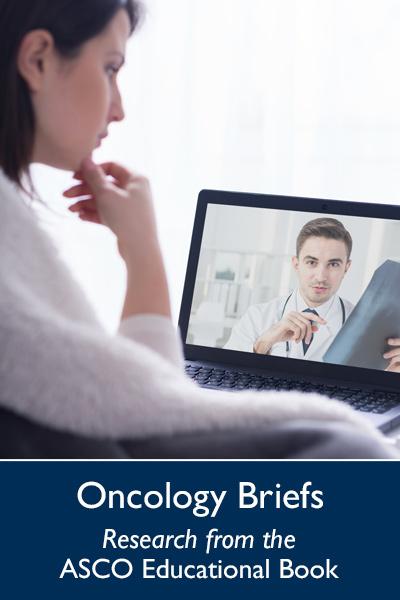
The ASCO Educational Book is a collection of articles written by ASCO Annual Meeting speakers and oncology experts. Published annually, each volume highlights the most compelling research and developments across many different fields of cancer care.
In collaboration with Cancer.Net, authors of the ASCO Educational Book have tailored their articles for patients and their loved ones.
Nathan A. Pennell, MD, PhD, is a Medical Oncologist specializing in hematology and medical oncology at the Cleveland Clinic. Adam P. Dicker, MD, PhD, is a Professor of Radiation Oncology, Pharmacology, and Experimental Therapeutics at The Sidney Kimmel Cancer Center at Thomas Jefferson University. Christine Tran, MS, studies at Thomas Jefferson University. Heather S.L. Jim, PhD, is a Postdoctoral Fellow of behavioral oncology research at the Moffitt Cancer Center. David L. Schwartz, MD, FACR, is a Radiation Oncologist at the West Cancer Center. Edward J. Stepanski, PhD, is a Professor at the University of Tennessee Health and Science Center.
Technology is everywhere. It’s on our wrist, tracking how many steps we take each day. It’s in the palm of our hand, as we check the latest updates on our Facebook or Twitter feed. It’s in our home, with smart TVs that stream shows recommended just for us.
Technology is making its mark in medicine as well. When you visit your doctor’s office, you may notice that electronic health records have replaced paper records. Many physicians take notes during an office visit using a tablet or desktop computer. Some doctors communicate with their patients over email.
When you visit your doctor’s office, you may notice that electronic health records have replaced paper records. Many physicians take notes during an office visit using a tablet or desktop computer. Some doctors communicate with their patients over email.
The use of technology in a health care setting goes by several names. Telehealth, telemedicine, eHealth, digital health, or mobile health (mHealth) all refer to a broad range of technologies that can deliver health care services. The goal of telehealth is to provide the same level of quality care that someone would receive in a traditional face-to-face visit with their doctor. Recent studies show that patients who have used telehealth tools have been satisfied with their experience.
Telehealth is appealing because it can overcome barriers to getting needed care—such as distance from a cancer center—and can reduce disruptions to patients’ daily lives. Many people like being able to use apps and digital tools to communicate with their doctor, giving them easier access to professional advice. Here are a few examples of how telehealth has the potential to improve patient care:
-
Care can be delivered anywhere. Interactive video conferencing tools like FaceTime and Skype can allow communication with doctors no matter how far someone is from major medical centers. Patients can wear sensors that measure everything from blood pressure, heart rate, and temperature to daily exercise and mood levels, allowing physicians to remotely monitor a patient’s health.
-
Shorter wait times at clinics or hospitals. Real-time location systems technology can reduce wait times in clinics and hospitals by monitoring the location of both patients and doctors. If a doctor hasn’t entered a room 15 minutes after patient, for example, a nurse is alerted to find the doctor. This technology is already being tested in large hospital systems, such as the Cleveland Clinic.
-
Reminders to help patients stay on top of their care. Something as simple as a text message reminder can help patients remember to take their medicine on schedule. Sharing updates on social media can help motivate and encourage people, such as to stick with that exercise program they started.
Telehealth may even have the potential to lengthen the lives of people with cancer. A study presented at the 2017 Annual Meeting of the American Society of Clinical Oncology found that patients with advanced cancer who used an online tool to report symptoms between visits to their doctor saw a 5-month increase in survival compared with patients who did not use the online tool. Patients who used the online tool also reported improved quality of life.
It is important to consider that telehealth is still in its early stages. Research has not yet shown which people will benefit the most from telehealth. For some, an in-person visit with their doctor is still best. Also, privacy and security need to be considered. Any telehealth technology must protect the privacy, confidentiality, and security of a patient’s data.
If you’re interested in what technology can offer you as a patient, start a conversation with your doctor. Be careful about entering personal health data into any app or online tool. Ask your doctor which apps might benefit you and see what they recommend.
More detailed information can be found in the ASCO Educational Book article from which this blog was based.
